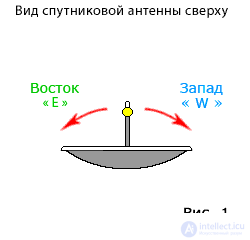Lecture
When positioning a satellite dish to a satellite, you will encounter basically two basic units of measurement, which determine the directionality of your antenna. They are expressed, as a rule, in degrees .
The first parameter is the horizontal position of the satellite dish . That is, the azimuth direction of the antenna mirror, from your point of location, which you will determine according to the compass ( Fig. 1 ). With a horizontal setting, we will move the mirror itself (reflector), to the EAST ( E - east), or to the WEST (W - west).

Positioning the satellite dish horizontally.
The second parameter is the vertical position of the satellite dish. That is, the angle of its slope. The antenna tilt angle ( Fig. 2 ) will directly depend on the height of the satellite itself, which means that the angle of ascent to the satellite or how it is also called elevation .

Positioning the satellite dish horizontally.
In the literature of similar subjects, or for example on the Internet, you can meet many different terms. I do not want to overburden you with enough abstruse terminology. Therefore, in the following sections, I will try to give only the necessary minimum. If you don’t understand a word, you can read its simplest definition in the Terms section (terms for beginners).
In conclusion of the study of the basics of the theory of satellite broadcasting, let us examine what the main advantages and disadvantages of the satellite reception itself will be.
The main advantages of satellite reception
The main disadvantages of satellite reception
In describing the shortcomings of satellite reception, you have come across such a term as solar activity. What it is? The fact is that the Sun emits not only the luminous flux, but also electromagnetic. Since the Earth rotates around the Sun, then there comes a period when your antenna , satellite (from which the signal is received), and the Sun begin to be on one straight line ( Fig. 1 ). At this moment, the solar electromagnetic noise flow blocks the signal coming from the satellite transponder.

First, the effect of freezing the image appears, and the sound disappears, and then the reception becomes completely impossible. The period of solar activity, which takes place on the days of the autumn and spring equinox, lasts approximately from one to two weeks, manifesting itself every day, at 5..10 minutes during this period.
Is it possible to get rid of solar activity adversely affecting satellite reception? Yes you can. Only for this, you will need to rearrange the satellite dish to another location, i.e. shift. And such "dances" will have to be done twice a year, on the days of the autumn and spring equinox. So, it is necessary to suffer a little, because 5..10 minutes, this is not so much.
Comments
To leave a comment
The television. Theory. Satellite
Terms: The television. Theory. Satellite